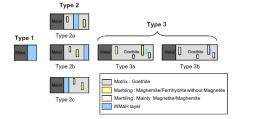Laboratoire Léon Brillouin
UMR12 CEA-CNRS, Bât. 563 CEA Saclay
91191 Gif sur Yvette Cedex, France
+33-169085241 llb-sec@cea.fr



Schematic evolution path of the corrosion layers in concrete (WMaH: mix of Wustite, Magnetite and Hematite).
Corrosion patterns on samples taken on binder and rebars from two buildings, respectively, aged of 46
and 260 years old have been characterised by coupling different analytical methods at microscopic scale.
Different corrosion patterns have been observed. The first one is constituted by the initial mill scale made
of wustite, magnetite and hematite. The second one contains remains of this mill scale embedded in
phases formed after aqueous corrosion: oxyhydroxides as goethite or lepidocrocite containing marblings
of ferrihydrite, maghemite and magnetite. On the thicker and older layers, marblings were only constituted
of magnetite and maghemite. It is proposed that the structural evolution of the pattern and their
marbling is linked to wet/dry cycles and/or pH condition evolution during the corrosion processes.
Demoulin, A., Trigance, C., Neff, D., Foy, E., Dillmann, P., L'hostis, V., 2010. The evolution of the corrosion of iron in hydraulic binders analysed from 46- and 260-year-old buildings, Corrosion Science 52, 3168-3179.
•  Matériaux des nouvelles technologies pour l’énergie › Corrosion long terme de matériaux métalliques / Long term corrosion of multimaterials containing metals › Solids, surfaces interfaces and materials
Matériaux des nouvelles technologies pour l’énergie › Corrosion long terme de matériaux métalliques / Long term corrosion of multimaterials containing metals › Solids, surfaces interfaces and materials  Physique, chimie, nanosciences et matériaux autour des grands instruments
Physique, chimie, nanosciences et matériaux autour des grands instruments
• Laboratoire archéomatériaux et prévision de l'altération (LAPA)

